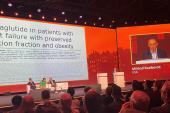Semaglutide Helps in HFpEF Irrespective of Frailty, Exercise Capacity
Indications that the GLP-1 drug has greater benefits in the most frail patients should be viewed cautiously, one expert says.

Once-weekly semaglutide (Wegovy; Novo Nordisk) improves outcomes in patients who have obesity-related heart failure with preserved ejection fraction (HFpEF) across subgroups defined by baseline 6-minute walk distance and frailty status, according to two prespecified analyses of the STEP-HFpEF program.
In the first, weight loss and improvement in HF-related symptoms and physical limitations assessed using the Kansas City Cardiomyopathy Questionnaire (KCCQ)—the co-primary endpoints—were consistently better with semaglutide versus placebo no matter patients’ 6-minute walk distance.
In the second, the amount of body weight lost was greater with the glucagon-like peptide-1 (GLP-1) receptor agonist than with placebo regardless of baseline frailty status, although the magnitude of improvement in KCCQ score appeared to be greater in patients with higher levels of frailty.
Both analyses were presented virtually after the Heart Failure Society of America (HFSA) 2024 meeting, planned to be held in Atlanta, GA, was canceled due to the approach of Hurricane Helene.
Christopher O’Connor, MD (Inova Heart and Vascular Institute, Falls Church, VA), a past president of the HFSA, discussed the findings after the two presentations.
“Semaglutide improves feel and function across the spectrum of baseline 6-minute walk distance, and I believe it does across the spectrum of frailty, although there may be an enhanced advantage on the KCCQ clinical summary score in the most frail patients. This needs to be validated in additional studies,” he said. “I think the fact that semaglutide improves frailty independent of weight loss, and it improves 6-minute walk distance, but correlated with weight loss, suggests that dual mechanisms are in play here.”
O’Connor commended the investigators for putting the spotlight on frailty and exercise capacity, saying, “These topics should be elevated to be prespecified and higher in the hierarchy of future investigations of HFpEF obesity studies of this drug class.”
Exercise Capacity in the STEP-HFpEF Program
The analyses pooled data on 1,145 patients with obesity-related HFpEF who participated in two trials—STEP-HFpEF (which excluded patients with known diabetes) and STEP-HFpEF DM (including those with type 2 diabetes). In both trials, once-weekly semaglutide 2.4 mg resulted in a greater loss in body weight and improvement in HF-related symptoms and physical limitations compared with placebo.
For the HFSA meeting, Mikhail Kosiborod, MD (Saint Luke’s Mid America Heart Institute, Kansas City, MO), presented the prespecified analysis according to baseline 6-minute walk distance. At this time point, patients with worse performance on the test tended to be older, have greater adiposity, have higher levels of inflammation (based on high-sensitivity C-reactive protein levels) and congestion (based on NT-proBNP levels), and have more severe HF symptoms and physical limitations.
Overall, semaglutide improved 6-minute walk distance, with the benefits seen as early as 20 weeks after randomization before the maximum amount of weight loss was obtained, Kosiborod said. By 1 year, the between-group difference in favor of semaglutide was about 17 meters (P < 0.0001).
Combining both the treatment and placebo arms, there was a significant relationship between 6-minute walk distance and the degree of weight loss. For patients who lost 5% to 10% of their body weight by 52 weeks, the estimated gain in distance with semaglutide was 17.1 meters, whereas for those who lost at least 20% of their body weight, the estimated difference was 34.7 meters.
Baseline 6-minute walk distance did not significantly influence the beneficial effects of semaglutide on either other co-primary endpoints, weight loss and improvement in KCCQ clinical summary score (P = NS for both interactions). The impact on other secondary and exploratory endpoints was similar across tertiles of 6-minute walk distance as well.
Although serious adverse events in the trial were more common in patients with poorer exercise capacity at baseline, rates were lower with semaglutide versus placebo across tertiles of walk distance, Kosiborod reported.
‘Intriguing’ Frailty Findings
Ambarish Pandey, MD (UT Southwestern Medical Center, Dallas, TX), reported a prespecified analysis of the pooled STEP-HFpEF cohort according to baseline frailty status, noting that “concerns have been raised in the clinical community about the effects of GLP-1 receptor agonists, especially regarding weight loss, in individuals with high frailty burden.”
Frailty was assessed using the Rockwood cumulative deficit approach, which incorporates 34 variables across multiple domains. Overall, 10% of patients were classified as nonfrail at baseline, 30% as more frail, and 60% as most frail. Those with a higher frailty burden were more likely to be women and to be older. They also had a higher body mass index, worse HF-related symptoms and exercise capacity, higher levels of NT-proBNP and high-sensitivity C-reactive protein, and less use of sodium-glucose cotransporter 2 (SGLT2) inhibitors.
The beneficial weight-loss effect of semaglutide was not significantly different across frailty categories (P = 0.385 for interaction).
Frailty status did, however, modify the effect of semaglutide on KCCQ clinical summary score, with the greatest benefit observed in the most frail patients (P < 0.001 for interaction). In that group, there was a significant 11-point difference favoring treatment versus placebo.
Patients with the highest level of frailty also tended to have greater increases in 6-minute walk distance with semaglutide, although the interaction was not significant (P = 0.141). For a hierarchical composite endpoint encompassing death, HF events, and changes in KCCQ, 6-minute walk distance, and high-sensitivity C-reactive protein, however, there was a more favorable win ratio for semaglutide in the most frail patients (P = 0.0024), Pandey reported.
Semaglutide also appeared to have a direct impact on frailty itself. From baseline to 52 weeks, the proportion of nonfrail patients increased from 10.3% to 53.2% and the proportion of most frail patients fell from 59.7% to 18.9% in the semaglutide arm. Trends were similar but less pronounced in the placebo arm, in which 40.7% of patients remained in the most frail category at 1 year.
“These findings support the use of semaglutide as an effective and well-tolerated therapy in the high-risk population of frail patients with obesity-related HFpEF,” Pandey said.
Is it the weight loss or is it the effect on the cardiometabolic status? And I think [with] the findings that we're seeing from these analyses, it suggests that it's both. Christopher O’Connor
O’Connor said the analysis Pandey presented “is so important because we often don't address frailty in our heart failure clinical trials” and he underscored how common it was for patients to be at the highest level of frailty in the trials. “This is something that I think is underappreciated and we should continue to study and also continue to validate these frailty indices because I don't think they've been studied well in obese HFpEF patients,” O’Connor suggested.
He said the indications that semaglutide has greater benefits in the most frail patients “is intriguing, but I think we have to view that with extreme caution.” The finding would imply, he said, that about 40% of patients didn’t receive a benefit from semaglutide on the KCCQ score. In addition, there was an attenuation of the finding when frailty was assessed as a continuous variable and the researchers did not adjust for multiple comparisons, he said.
Perhaps the most intriguing finding, though, is that semaglutide improved frailty status, O’Connor said. “I think this finding could have important implications that go beyond HFpEF, and I think this is really something we need to continue to investigate further.”
He contrasted the two analyses that were presented, noting that frailty did not correlate with the degree of weight loss with semaglutide, but 6-minute walk distance did.
“That brings us back to the question and the debate that we have with this drug class: is it the weight loss or is it the effect on the cardiometabolic status? And I think [with] the findings that we're seeing from these analyses, it suggests that it's both,” said O’Connor.
Todd Neale is the Associate News Editor for TCTMD and a Senior Medical Journalist. He got his start in journalism at …
Read Full BioSources
Pandey A. Efficacy of semaglutide in patients with obesity and HFpEF according to frailty status: a pooled analysis from the STEP-HFpEF program. Presented at: HFSA 2024. September 29, 2024.
Kosiborod M. Effects of semaglutide in patients with obesity-related heart failure with preserved ejection fraction according to the exercise function at baseline: insights from the STEP-HFpEF program. Presented at: HFSA 2024. September 29, 2024.
Disclosures
- STEP-HFpEF was funded by Novo Nordisk.
- Pandey reports receiving research support from the American Heart Association, Applied Therapeutics, Gilead Sciences, the National Institutes of Health, Roche, and Ultromics; being an advisor/consultant for Axon Therapies, Bayer, Cytokinetics, Edwards Lifesciences, Emmi Solutions, Lilly USA, Medtronic, Merck, Novo Nordisk, Rivus, Roche Diagnostics, Sarfez Pharmaceuticals, Science 37, Semler Scientific, and Tricog Health; speaking for AstraZeneca, Bayer, Boehringer Ingelheim, Impulse Dynamics, Merck, and Vifor Pharma; receiving nonfinancial support from Pfizer and Merck; and receiving stocks for consulting for Palomarin Inc.
- Kosiborod reports receiving research support from AstraZeneca, Boehringer Ingelheim, and Pfizer; having advisory/consulting roles with 35Pharma, Alnylam Pharmaceuticals, Amgen, Applied Therapeutics, AstraZeneca, Bayer, Boehringer Ingelheim, Cytokinetics, Dexcom, Eli Lilly, Esperion Therapeutics, Imbria Pharmaceuticals, Janssen, Lexicon Pharmaceuticals, Merck (Diabetes and Cardiovascular), Novo Nordisk, Pharmacosmos, Pfizer, Sanofi, scPharmaceuticals, Structure Therapeutics, CSL Vifor, and Youngene Therapeutics; receiving speaking fees from AstraZeneca, Bayer, Boehringer Ingelheim, Impulse Dynamics, Merck, and Vifor Pharma; receiving honoraria from AstraZeneca, Boehringer Ingelheim, and Novo Nordisk; and owning stocks from Artera and Saghmos Therapeutics.





Comments